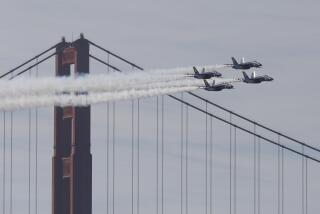Intercept Team Plays Hardball on the High Seas
- Share via
ABOARD THE USS ROANOKE — Packing firepower and wearing scowls, about 65 Marines and Navy Seals on Friday demonstrated how to take over a “hostile” ship at sea.
The joint military exercise, which included three ships, half a dozen helicopters and a pair of rigid-hull inflatable boats, was a chance for Marine Corps and Navy brass to offer a rare glimpse into how they have stopped vessels in the Arabian Gulf--and elsewhere in the world--that are suspected of violating United Nations sanctions.
Camp Pendleton Marines quickly slid down ropes from CH-46 choppers, then trained guns on men who played the role of civilian crew members.
After the first helicopter hovered over the moving ship’s rear deck, it took only 30 seconds for a dozen Marines to fan out and begin seizing control of the Roanoke, a 658-foot-long replenishment oiler that was used as a commercial tanker for the exercise about 40 miles off the coast of San Diego.
Navy Lt. Commander Mike Coomes said that most of the time a civilian ship’s crew complies when asked to allow U.S. military personnel aboard to check its contents and records.
“That’s the ideal scenario,” Coomes said.
But Friday’s drill was to prepare for the rare instances when such cooperation doesn’t occur.
Most of the Navy Seals who clambered up a rope from small boats to get on the deck of the Roanoke did not respond to questions from reporters who were invited to watch and stand amid the action.
At a media briefing earlier in the morning aboard the amphibious assault ship New Orleans, officials explained that “Maritime Interception Operations” can become dangerous if those on the ship in question are armed and unwilling to stop for inspection.
“We’re prepared to use deadly force if necessary, but that’s not our desire,” Marine Lt. Col Dan Pollock said.
Ship interceptions were commonplace during the Persian Gulf War.
Now the numbers have “dwindled,” with the most recent ship interception being in December, Marine Col. Robert B. Blose Jr. said.
But that didn’t deter Force Recon Marines and others from Battalion 21 at Camp Pendleton, and Navy Seals based at Coronado.
“It was exciting,” said Lance Cpl. Gerald Moose, a 20-year-old Marine at Camp Pendleton. “It really got your adrenaline pumping.”
As Moose kept the muzzle of his M-16 rifle pointed toward the rear of the ship, other Marines and Navy Seals held different positions to secure it. Those who acted as civilian crew members were handcuffed with plastic restraints and guarded.
Marines with an interrogation team also shot photographs and videotape.
Sgt. Bryon Saltzman said he took about 40 minutes of videotape, including crew members being questioned, the ship’s bridge and even the combination to the ship’s safe.
Saltzman, who speaks Persian, Farsi and Spanish, was on the first of four helicopters that dropped off Marines. He was one of the last to leave the ship.
When asked if he had ever participated in an actual ship interception, Saltzman, an 11-year veteran, remained ever the careful Marine.
“I’m not at liberty to say,” he said.
More to Read
Sign up for Essential California
The most important California stories and recommendations in your inbox every morning.
You may occasionally receive promotional content from the Los Angeles Times.










